Claudio Gallicchio
Ray-Tracing for Conditionally Activated Neural Networks
Feb 20, 2025


Abstract:In this paper, we introduce a novel architecture for conditionally activated neural networks combining a hierarchical construction of multiple Mixture of Experts (MoEs) layers with a sampling mechanism that progressively converges to an optimized configuration of expert activation. This methodology enables the dynamic unfolding of the network's architecture, facilitating efficient path-specific training. Experimental results demonstrate that this approach achieves competitive accuracy compared to conventional baselines while significantly reducing the parameter count required for inference. Notably, this parameter reduction correlates with the complexity of the input patterns, a property naturally emerging from the network's operational dynamics without necessitating explicit auxiliary penalty functions.
Long Range Propagation on Continuous-Time Dynamic Graphs
Jun 04, 2024



Abstract:Learning Continuous-Time Dynamic Graphs (C-TDGs) requires accurately modeling spatio-temporal information on streams of irregularly sampled events. While many methods have been proposed recently, we find that most message passing-, recurrent- or self-attention-based methods perform poorly on long-range tasks. These tasks require correlating information that occurred "far" away from the current event, either spatially (higher-order node information) or along the time dimension (events occurred in the past). To address long-range dependencies, we introduce Continuous-Time Graph Anti-Symmetric Network (CTAN). Grounded within the ordinary differential equations framework, our method is designed for efficient propagation of information. In this paper, we show how CTAN's (i) long-range modeling capabilities are substantiated by theoretical findings and how (ii) its empirical performance on synthetic long-range benchmarks and real-world benchmarks is superior to other methods. Our results motivate CTAN's ability to propagate long-range information in C-TDGs as well as the inclusion of long-range tasks as part of temporal graph models evaluation.
Injecting Hamiltonian Architectural Bias into Deep Graph Networks for Long-Range Propagation
May 27, 2024



Abstract:The dynamics of information diffusion within graphs is a critical open issue that heavily influences graph representation learning, especially when considering long-range propagation. This calls for principled approaches that control and regulate the degree of propagation and dissipation of information throughout the neural flow. Motivated by this, we introduce (port-)Hamiltonian Deep Graph Networks, a novel framework that models neural information flow in graphs by building on the laws of conservation of Hamiltonian dynamical systems. We reconcile under a single theoretical and practical framework both non-dissipative long-range propagation and non-conservative behaviors, introducing tools from mechanical systems to gauge the equilibrium between the two components. Our approach can be applied to general message-passing architectures, and it provides theoretical guarantees on information conservation in time. Empirical results prove the effectiveness of our port-Hamiltonian scheme in pushing simple graph convolutional architectures to state-of-the-art performance in long-range benchmarks.
Tackling Graph Oversquashing by Global and Local Non-Dissipativity
May 02, 2024



Abstract:A common problem in Message-Passing Neural Networks is oversquashing -- the limited ability to facilitate effective information flow between distant nodes. Oversquashing is attributed to the exponential decay in information transmission as node distances increase. This paper introduces a novel perspective to address oversquashing, leveraging properties of global and local non-dissipativity, that enable the maintenance of a constant information flow rate. Namely, we present SWAN, a uniquely parameterized model GNN with antisymmetry both in space and weight domains, as a means to obtain non-dissipativity. Our theoretical analysis asserts that by achieving these properties, SWAN offers an enhanced ability to transmit information over extended distances. Empirical evaluations on synthetic and real-world benchmarks that emphasize long-range interactions validate the theoretical understanding of SWAN, and its ability to mitigate oversquashing.
Awareness in robotics: An early perspective from the viewpoint of the EIC Pathfinder Challenge "Awareness Inside''
Feb 14, 2024Abstract:Consciousness has been historically a heavily debated topic in engineering, science, and philosophy. On the contrary, awareness had less success in raising the interest of scholars in the past. However, things are changing as more and more researchers are getting interested in answering questions concerning what awareness is and how it can be artificially generated. The landscape is rapidly evolving, with multiple voices and interpretations of the concept being conceived and techniques being developed. The goal of this paper is to summarize and discuss the ones among these voices connected with projects funded by the EIC Pathfinder Challenge called ``Awareness Inside'', a nonrecurring call for proposals within Horizon Europe designed specifically for fostering research on natural and synthetic awareness. In this perspective, we dedicate special attention to challenges and promises of applying synthetic awareness in robotics, as the development of mature techniques in this new field is expected to have a special impact on generating more capable and trustworthy embodied systems.
Edge of stability echo state networks
Aug 05, 2023Abstract:In this paper, we propose a new Reservoir Computing (RC) architecture, called the Edge of Stability Echo State Network (ES$^2$N). The introduced ES$^2$N model is based on defining the reservoir layer as a convex combination of a nonlinear reservoir (as in the standard ESN), and a linear reservoir that implements an orthogonal transformation. We provide a thorough mathematical analysis of the introduced model, proving that the whole eigenspectrum of the Jacobian of the ES2N map can be contained in an annular neighbourhood of a complex circle of controllable radius, and exploit this property to demonstrate that the ES$^2$N's forward dynamics evolves close to the edge-of-chaos regime by design. Remarkably, our experimental analysis shows that the newly introduced reservoir model is able to reach the theoretical maximum short-term memory capacity. At the same time, in comparison to standard ESN, ES$^2$N is shown to offer a favorable trade-off between memory and nonlinearity, as well as a significant improvement of performance in autoregressive nonlinear modeling.
Anti-Symmetric DGN: a stable architecture for Deep Graph Networks
Oct 18, 2022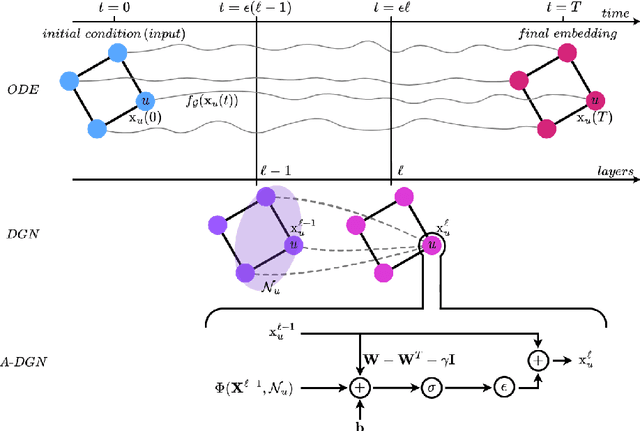
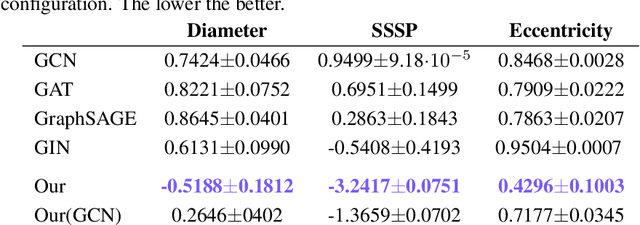
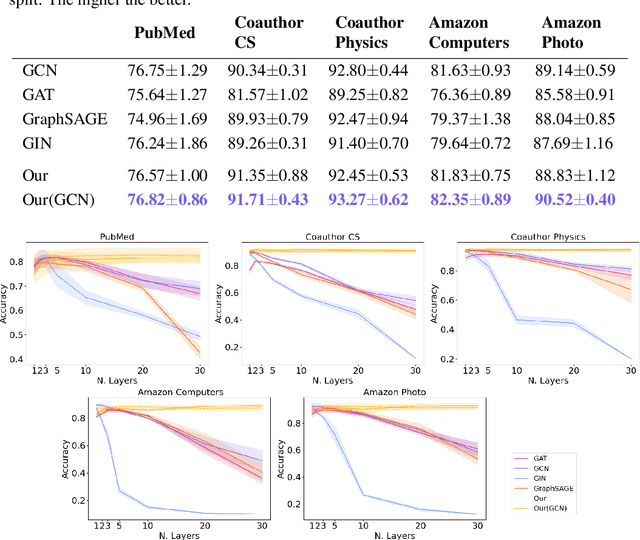

Abstract:Deep Graph Networks (DGNs) currently dominate the research landscape of learning from graphs, due to their efficiency and ability to implement an adaptive message-passing scheme between the nodes. However, DGNs are typically limited in their ability to propagate and preserve long-term dependencies between nodes, \ie they suffer from the over-squashing phenomena. This reduces their effectiveness, since predictive problems may require to capture interactions at different, and possibly large, radii in order to be effectively solved. In this work, we present Anti-Symmetric Deep Graph Networks (A-DGNs), a framework for stable and non-dissipative DGN design, conceived through the lens of ordinary differential equations. We give theoretical proof that our method is stable and non-dissipative, leading to two key results: long-range information between nodes is preserved, and no gradient vanishing or explosion occurs in training. We empirically validate the proposed approach on several graph benchmarks, showing that A-DGN yields to improved performance and enables to learn effectively even when dozens of layers are used.
Continual Learning for Human State Monitoring
Jun 29, 2022



Abstract:Continual Learning (CL) on time series data represents a promising but under-studied avenue for real-world applications. We propose two new CL benchmarks for Human State Monitoring. We carefully designed the benchmarks to mirror real-world environments in which new subjects are continuously added. We conducted an empirical evaluation to assess the ability of popular CL strategies to mitigate forgetting in our benchmarks. Our results show that, possibly due to the domain-incremental properties of our benchmarks, forgetting can be easily tackled even with a simple finetuning and that existing strategies struggle in accumulating knowledge over a fixed, held-out, test subject.
Deep Features for CBIR with Scarce Data using Hebbian Learning
May 18, 2022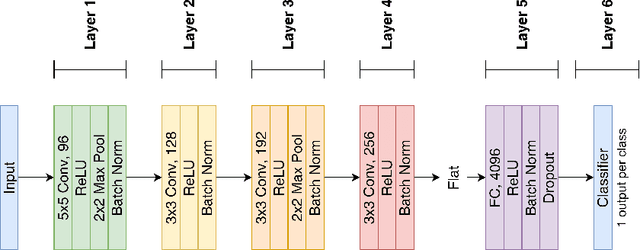
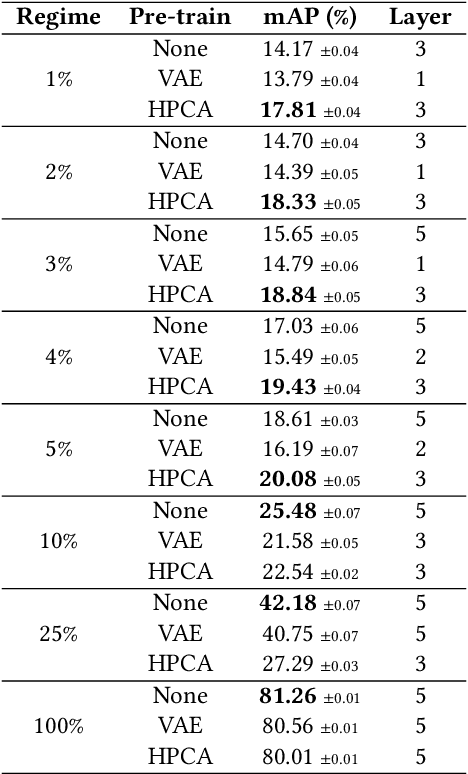
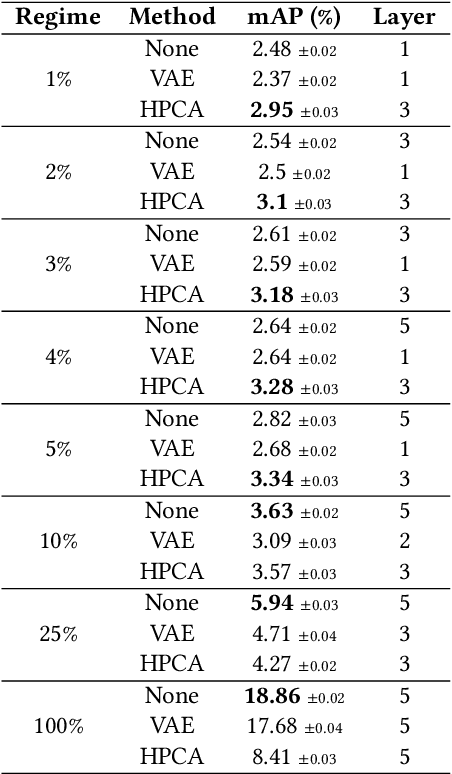
Abstract:Features extracted from Deep Neural Networks (DNNs) have proven to be very effective in the context of Content Based Image Retrieval (CBIR). In recent work, biologically inspired \textit{Hebbian} learning algorithms have shown promises for DNN training. In this contribution, we study the performance of such algorithms in the development of feature extractors for CBIR tasks. Specifically, we consider a semi-supervised learning strategy in two steps: first, an unsupervised pre-training stage is performed using Hebbian learning on the image dataset; second, the network is fine-tuned using supervised Stochastic Gradient Descent (SGD) training. For the unsupervised pre-training stage, we explore the nonlinear Hebbian Principal Component Analysis (HPCA) learning rule. For the supervised fine-tuning stage, we assume sample efficiency scenarios, in which the amount of labeled samples is just a small fraction of the whole dataset. Our experimental analysis, conducted on the CIFAR10 and CIFAR100 datasets shows that, when few labeled samples are available, our Hebbian approach provides relevant improvements compared to various alternative methods.
Euler State Networks
Mar 17, 2022



Abstract:Inspired by the numerical solution of ordinary differential equations, in this paper we propose a novel Reservoir Computing (RC) model, called the Euler State Network (EuSN). The introduced approach makes use of forward Euler discretization and antisymmetric recurrent matrices to design reservoir dynamics that are both stable and non-dissipative by construction. Our mathematical analysis shows that the resulting model is biased towards unitary effective spectral radius and zero local Lyapunov exponents, intrinsically operating at the edge of stability. Experiments on synthetic tasks indicate the marked superiority of the proposed approach, compared to standard RC models, in tasks requiring long-term memorization skills. Furthermore, results on real-world time series classification benchmarks point out that EuSN is capable of matching (or even surpassing) the level of accuracy of trainable Recurrent Neural Networks, while allowing up to 100-fold savings in computation time and energy consumption.
 Add to Chrome
Add to Chrome Add to Firefox
Add to Firefox Add to Edge
Add to Edge